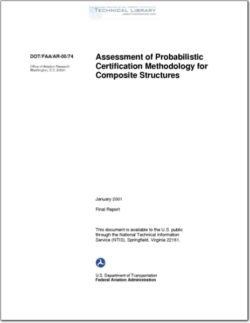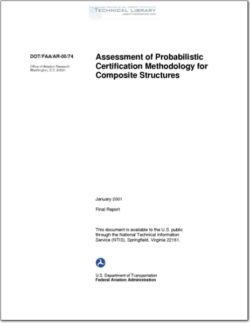DOT-FAA-AR-00-74

- Version
- 208 Downloads
- 386.44 KB File Size
- 1 File Count
- March 24, 2016 Create Date
- March 24, 2016 Last Updated
Assessment of Probabilistic Certification Methodology for Composite Structures

The application of composite materials to primary aircraft structures requires proven certification
procedures for demonstration of structural integrity. In the development of certification
procedures, the inherent characteristics of composites must be recognized. One of these
characteristics is the variability in strength and fatigue life data. This variability, while higher
than that observed in metals, although not negating the weight efficiency of composites
structures, must be accounted for in the certification process. Because of the strength and fatigue
data scatter in composites, the structural reliability provided by the conventional deterministic
certification approach is different for composite and metal structures. In order to certify
composite structures with the same level of confidence as metallic structures, a probabilistic-
based methodology is of interest. In addition to the scatter in strength and life data, the
uncertainties of the applied loads also affect the reliability of a structure. A factor of safety of
1.5, traditionally used in aircraft structural design, generally provides a very high level of
reliability. However, a safety of factor approach cannot be used to assess the risk involved in a
structural design. The probabilistic certification method will provide this additional information
which can be used for more efficient structural design.
The Federal Aviation Administration (FAA) has published Advisory Circular (AC) 20'107A [l]
as a certification guide for composite structures. An overview of FAA composite certification
activities is presented in reference 2, while the important considerations of AC 20'107A can be
found in reference 3. The FAA has also funded a series of research programs [4-9] to evaluate
various approaches to static strength and fatigue life certification of composite structures. A
probabilistic design methodology developed recently under Interagency Agreement DTFA03-84-
A-4002l by Northrop Grumman Commercial Aircraft Division (NGCAD) is discussed in
reference 10. A continuation of that work is reported in reference 11. A brief assessment of the
FAA certification activities described in references 2 through 9 indicates that a comprehensive
probabilistic methodology may be advantageous.
The objective of this program was to assess the suitability of the probabilistic approach for the
certification of composite structures and to identify the critical elements encountered in the
development of such a methodology. This was done using two methodologies [10 and 12] and
one software program [10] developed under FAA funding. A sensitivity study, using these
probabilistic methods and available composite aircraft structures, was carried out to identify key
parameters. Finally, based on the results of the sensitivity study, a certification approach is
suggested for FAA consideration.
| File | Action |
|---|---|
| DOT-FAA-AR-00-74 Assessment of Probabilistic Certification Methodology for Composite Structures.pdf | Download |

Comment On This Post